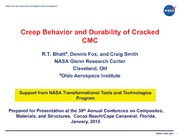
NASA Technical Reports Server (NTRS) 20150004096: Creep Behavior and Durability of Cracked CMC PDF
Preview NASA Technical Reports Server (NTRS) 20150004096: Creep Behavior and Durability of Cracked CMC
National Aeronautics and Space Administration Creep Behavior and Durability of Cracked CMC R.T. Bhatt#, Dennis Fox, and Craig Smith NASA Glenn Research Center Cleveland, OH #Ohio Aerospace Institute Support from NASA Transformational Tools and Technologies Program Prepared for Presentation at the 39th Annual Conference on Composites, Materials, and Structures, Cocoa Beach/Cape Canaveral, Florida, January, 2015 www.nasa.gov 1 National Aeronautics and Space Administration Objective and Approach Objective: Short term: Determine creep and cyclic fatigue properties, failure modes and durability of pre-cracked 2D woven SiC/SiC composites at temperatures to 14500C in air. Long term: Develop and validate physics based model to predict durability of cracked CMCs under creep and cyclic fatigue conditions in inert and oxidizing environments Approach: • Pre-crack CMCs at room temperature. • Creep test pre-cracked CMCs under furnace and burner rig conditions. • Fatigue test pre-cracked CMCs under furnace conditions. • Analyze deformation mechanisms/ failure modes. • If pre-cracked CMCs survive >100hr creep/fatigue tests, then measure residual in-plane tensile properties at room temperature. www.nasa.gov 2 National Aeronautics and Space Administration Material and Characterization Materials and Vendors: Fibers: Sylramic-iBN and Hi-Nicalon-S Interface coating: CVI BN Composites: - 2D woven 5HS balanced melt infiltrated SiC/SiC composites (GE Composites, Delaware) - 2D woven 5HS balanced chemical vapor infiltrated SiC/SiC composites (Rolls-Royce High Temperature Composites Inc (Formerly Hyper-Therm HTC, Huntington Beach, CA) Experimental variables: Stress: 35, 69, and 103 MPa Temperature: 13000C and 14500C Time: 100 to 200hrs R ratio: 0.5 Environment: air, Burner rig Pre-cracking stress @RT: 150-200MPa Characterization: Tensile, Creep, and Sustained peak low cycle fatigue (SPLCF) tests, Acoustic emission (AE) and SEM. www.nasa.gov 3 National Aeronautics and Space Administration Factors Influencing Durability of Cracked CMCs Predicted Crack Opening Displacement (COD) With Applied Stress for Fiber Reinforced CMCs 0.000006 m) - Matrix crack opening displacement r(1(cid:16) f)E nt (c0.000005 (cid:71)(cid:32) 4(cid:87)f 2E Em (cid:86)2 - Extant of crack e f c m - Matrix crack healing capability c0.000004 a - Crack tip intensity pl dis0.000003 - Diffusivity/ permeability of oxygen g n - Temperature ni0.000002 e p - Environment o ck 0.000001 - Creep/slow crack growth a r c 0 - Stress 0 100 200 300 - Time Applied Stress (MPa) - Gas velocity (cid:71) = Crack opening displacement - Location of the primary crack r = Fiber radius f = Fiber fraction - Crack spacing E = Elastic modulus of the matrix E = Elastic modulus of the fiber E = Elastic modulus of the composite (cid:86)(cid:3)(cid:3)(cid:3)= Applied stress (cid:87) = Interfacial shear strength between the fiber and the matrix Marshall D.B., Cox B.N., Evans A.G., “The mechanics of matrix cracking in brittle-matrix fiber composites,” Actametall. Vol. 33, No. 11, pp 2013-2021, 1985. Morscher G.N. and Cawley J.D., “Intermediate temperature strength degradation in SiC/SiC composites,” Journal of the European Ceramic Society Vol. 22, pp 2777-2787, 2002. www.nasa.gov 4 National Aeronautics and Space Administration Tensile Creep Behaviors of Pre-cracked 2D Balanced MI SiC/SiC Composites with Sylramic-iBN Fibers (Creep Conditions: 13150C/69 or 103 MPa /Air) Pre-cracked/Crept at 103 MPa Pre-cracked/Crept at 69 MPa Matrix cracks in the pre-cracked MI SiC/SiC composites healed during creep testing and significantly reduced fiber oxidation. The creep curves follow fiber creep data. www.nasa.gov 5 National Aeronautics and Space Administration Room Temperature Tensile Stress-Strain Behaviors of Pre-cracked 2D Balanced MI SiC/SiC Composites With Sylramic-iBN Fibers Before and After Creep Test (Creep Conditions: 13150C/69 and 103MPa /Air) As-Produced (Un-cracked) Pre-cracked/Crept at 103 MPa for 235hrs Pre-cracked/Crept at 69 MPa for 200hrs Pre-cracked/un-crept Pre-cracked and crept MI SiC/SiC composites retain > 80% of room temperature in-plane tensile properties. www.nasa.gov 66 National Aeronautics and Space Administration Pre-cracked Uncoated MI Sylramic-iBN SiC/SiC Composite Specimens Creep Tested at 13150C for Up To 235hrs and Then Tensile Tested at Room Temperature 69MPa/200hrs Heated Zone 103MPa/235hrs Precracked and crept MI SiC/SiC composites tensile tested at room temperature fail in the gage section. The red arrows indicate tensile fractured region. www.nasa.gov 77 National Aeronautics and Space Administration SEM Photographs of a Pre-cracked Uncoated MI Sylramic-iBN SiC/SiC Composite Specimen Creep Tested at 13150C/103MPa/235hrs and Then Tensile Tested at Room Temperature 3 2 1 www.nasa.gov 8 National Aeronautics and Space Administration SEM Photograph of Region 1 CVI BN www.nasa.gov 9 National Aeronautics and Space Administration SEM Photograph of Region 2 CVI BN BN+SiO 2 CVI SiC www.nasa.gov 10
